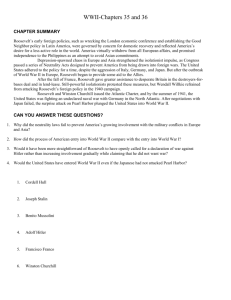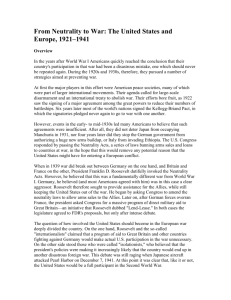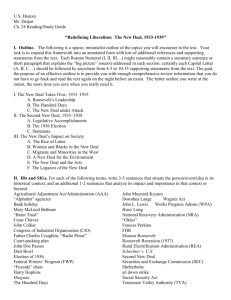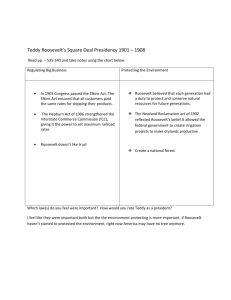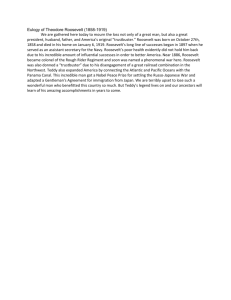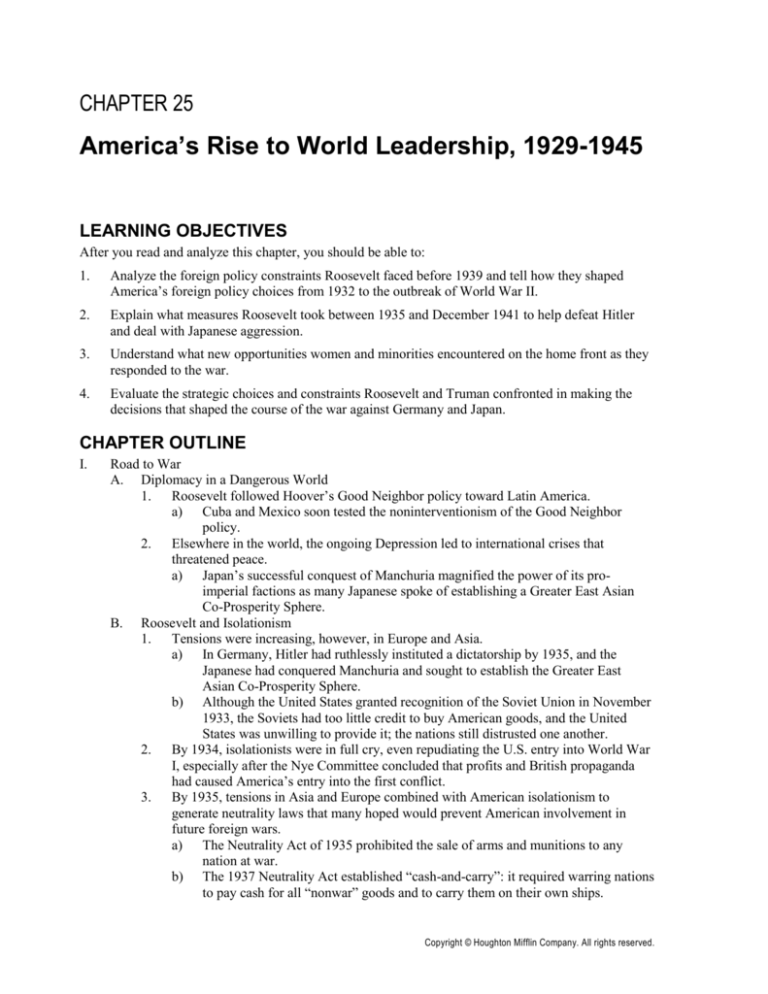
CHAPTER 25
America’s Rise to World Leadership, 1929-1945
LEARNING OBJECTIVES
After you read and analyze this chapter, you should be able to:
1.
Analyze the foreign policy constraints Roosevelt faced before 1939 and tell how they shaped
America’s foreign policy choices from 1932 to the outbreak of World War II.
2.
Explain what measures Roosevelt took between 1935 and December 1941 to help defeat Hitler
and deal with Japanese aggression.
3.
Understand what new opportunities women and minorities encountered on the home front as they
responded to the war.
4.
Evaluate the strategic choices and constraints Roosevelt and Truman confronted in making the
decisions that shaped the course of the war against Germany and Japan.
CHAPTER OUTLINE
I.
Road to War
A. Diplomacy in a Dangerous World
1. Roosevelt followed Hoover’s Good Neighbor policy toward Latin America.
a) Cuba and Mexico soon tested the noninterventionism of the Good Neighbor
policy.
2. Elsewhere in the world, the ongoing Depression led to international crises that
threatened peace.
a) Japan’s successful conquest of Manchuria magnified the power of its proimperial factions as many Japanese spoke of establishing a Greater East Asian
Co-Prosperity Sphere.
B. Roosevelt and Isolationism
1. Tensions were increasing, however, in Europe and Asia.
a) In Germany, Hitler had ruthlessly instituted a dictatorship by 1935, and the
Japanese had conquered Manchuria and sought to establish the Greater East
Asian Co-Prosperity Sphere.
b) Although the United States granted recognition of the Soviet Union in November
1933, the Soviets had too little credit to buy American goods, and the United
States was unwilling to provide it; the nations still distrusted one another.
2. By 1934, isolationists were in full cry, even repudiating the U.S. entry into World War
I, especially after the Nye Committee concluded that profits and British propaganda
had caused America’s entry into the first conflict.
3. By 1935, tensions in Asia and Europe combined with American isolationism to
generate neutrality laws that many hoped would prevent American involvement in
future foreign wars.
a) The Neutrality Act of 1935 prohibited the sale of arms and munitions to any
nation at war.
b) The 1937 Neutrality Act established “cash-and-carry”: it required warring nations
to pay cash for all “nonwar” goods and to carry them on their own ships.
Copyright © Houghton Mifflin Company. All rights reserved.
Chapter 25: America’s Rise to World Leadership, 1929-1945
C.
D.
E.
317
War and American Neutrality
1. As Europe rushed into war, the United States had little desire to come to the aid of
Poland, Britain, or France, and public isolationism remained strong.
a) Roosevelt had a different view because he was determined to do everything
possible, short of war, to help those nations opposing Hitler.
b) When Germany invaded Poland, FDR proclaimed the nation neutral but
emphasized that he could not ask Americans to be neutral in their thoughts.
2. The Third Neutrality Act of 1939 allowed any nation to buy weapons from the United
States, but Roosevelt knew that the British navy would deny the Germans access.
a) As Roosevelt shaped American neutrality, Hitler mopped up Polish resistance
and quietly readied his army for an attack on the West in the spring.
b) Not so secretly, the Soviets continued their expansion by incorporating the Baltic
Republics.
c) Germany and Italy, called the Axis powers, controlled almost all of western and
central Europe, leaving Britain to face the seemingly invincible German army
and air force alone.
d) Britain’s new prime minister, Winston Churchill, however, was already turning
to Roosevelt for aid; Roosevelt responded favorably to his requests.
e) The Burke-Wadsworth Act was the first peacetime military draft in the nation’s
history, and by the end of 1940, Congress had approved over $37 billion in
military expenditures—more than the total cost of World War I.
f)
The election results in 1940 demonstrated solid personal support for Roosevelt
but not for the Democratic Party, which lost three Senate seats.
The Battle for the Atlantic
1. By December 1940, Churchill had asked Roosevelt for loans to pay for supplies and
for help to protect merchant ships from German submarines, and Roosevelt again
agreed.
a) Roosevelt presented Congress with the Lend-Lease Bill, which would allow the
president to lend, lease, or in any way dispose of war materials to any country
considered vital to American security.
2. With the Battle for the Atlantic reaching a turning point, Roosevelt and Churchill met
secretly in August 1941, and, for the first time, both leaders sensed some room for
optimism.
a) Churchill and Roosevelt produced the Atlantic Charter, which set forth the
Wilsonian goals of self-determination, freedom of trade on the seas, no territorial
gains, and the establishment of a “permanent system of general security” in the
form of a new world organization.
Pearl Harbor
1. Throughout 1941, FDR had to balance Britain’s desperate needs with those of his own
military, which pressed him for more equipment to strengthen the nation’s position in
the Pacific.
a) Since 1937, Japanese troops had seized more and more of coastal China, while
the United States did little but protest.
b) In July 1940, Roosevelt acted on public sentiment and placed some restrictions
on Japanese-American trade, forbidding the sale and shipment of aviation fuel
and scrap iron.
c) Americans prepared for war, but Japan moved first.
2. The Japanese planned to attack the American fleet anchored at Pearl Harbor.
a) Seven battleships were destroyed or badly damaged and 11 others were hit,
nearly 200 aircraft were destroyed, and 2,500 Americans died.
Copyright © Houghton Mifflin Company. All rights reserved.
318
Chapter 25: America’s Rise to World Leadership, 1929-1945
b)
II.
Fortunately, the U.S. aircraft carriers were on maneuvers in the Pacific and not at
Pearl Harbor and the repair shops, dry docks, and oil storage tanks incurred only
light damage.
3. On December 8, the United States declared war on Japan, and Germany and Italy soon
declared war on the United States.
America Responds to War
A. Japanese American Internment
1. The feelings against Japanese Americans were a product of long-standing racist
attitudes and an immediate reaction to the war.
a) Although some doubted the reality of any threat from the Japanese American
community, no one came forward to protest its treatment.
b) In 1942, FDR signed Executive Order #9066, which allowed the military to
remove anyone deemed a threat from official military areas; the entire West
Coast was declared a military area.
c) By the summer of 1942, over 110,000 Nisei and Issei had been transported to 10
internment camps.
d) Aware of rapidly growing anti-Japanese public opinion, Roosevelt waited until
after the 1943 elections to allow internees who passed a loyalty review to go
home; a year later, the camps were empty.
B. Mobilizing the Nation for War
1. President Roosevelt called on Americans to produce the goods necessary for victory,
and any anti-business attitude disappeared.
a) By 1942, one-third of all American production was geared to the war, and the
government was allocating millions of dollars to improve production and to build
new plants in vital industries like aluminum and synthetic rubber.
b) By the end of the war, the United States had pumped over $320 billion into the
American economy, and the final production amounts exceeded almost
everyone’s expectations.
2. As the nation’s economy began to retool to become the arsenal of democracy, the
Office of Price Administration was established to control prices and inflation.
a) In May 1943, Roosevelt further expanded government planning and direction
over the economy by establishing the Office of War Mobilization.
b) The war brought an end to the Depression and created full employment.
C. Wartime Politics
1. As Roosevelt mobilized the nation for war, Republicans and conservative Democrats
moved to bury what was left of the New Deal.
a) To keep the social image of the New Deal alive during the election year of 1944,
Roosevelt called for a GI Bill of Rights and a commitment to achieving “freedom
from want.”
b) Roosevelt won reelection against Republican Thomas Dewey in 1940.
D. A People at Work and War
1. One sure sign of war was that people were moving and taking new jobs as never
before.
a) To fill the gaps in the workforce, employers increasingly turned to those
excluded prior to the war: women and minorities.
b) With their expanding populations, war industrial cities experienced massive
problems providing homes, water, electricity, and sanitation.
c) Contributing to the old problem of prostitution was the new problem posed by
many unsupervised teenage children.
E. New Opportunities and Old Constraints in Wartime
Copyright © Houghton Mifflin Company. All rights reserved.
Chapter 25: America’s Rise to World Leadership, 1929-1945
1.
319
Minorities and women confronted new roles and accepted new responsibilities, both on
the home front and in the military.
2. The military branches were pushed to create new roles for women.
3. As more jobs opened, women did fill them—some because of patriotism, but most
because they wanted both the job and the wages.
a) Despite the patriotic appeal and image, not all was ideal at work, since male
workers often resented and harassed women and continually reminded them that
their jobs were temporary.
4. Like the war experiences of women, those of minorities were mixed.
a) New employment and social opportunities existed, but they were accompanied by
increased racial and ethnic tensions and the knowledge that, when the war ended,
the opportunities were likely to vanish.
b) The opportunities and realities of African Americans in uniform matched those of
black civilians.
c) Mexican Americans, too, found new opportunities during the war while
encountering continued segregation and hostility.
III. Waging World War
A. Halting the Japanese Advance
1. In the Pacific theater, the victory at Midway in mid-1942 gave American forces naval
and air superiority over Japan and allowed the use of carrier task forces to begin
tightening the noose around Japan.
B. The Tide Turns in Europe
1. In Europe, too, the Allies began to meet with some success, although at great cost.
a) While the British and Americans advanced across France, Allied bombers and
fighter-bombers were doing what they had been doing since the spring of 1942,
bombing German-held Europe night and day.
b) Vital industries and transportation systems were destroyed by what at times
seemed to be around-the-clock bombing.
2. At the Tehran Conference, the Big Three agreed to coordinate a Soviet offensive with
Allied landings at Normandy.
a) Operation Overlord was the greatest amphibious assault ever assembled.
C. Stresses in the Grand Alliance
1. In February 1945, the Big Three met at Yalta amid growing apprehension about Soviet
territorial and political goals in Eastern Europe.
a) First and foremost, Roosevelt needed a Soviet declaration of war on Japan and
support for the new United Nations, since both were necessary to usher in peace
and international stability.
b) Roosevelt permitted Stalin to keep what he already had, or could easily take, to
ensure Soviet cooperation.
D. Defeating Hitler
1. The Battle of the Bulge cost Germany valuable reserves and equipment, and ultimately
it merely hastened the end of the war.
a) At the end of April, Hitler committed suicide, since he was unwilling to be
captured.
b) Roosevelt died of a massive cerebral hemorrhage a few weeks before.
2. Hitler’s Holocaust was responsible for the killing of six million civilian Jews.
E. Closing the Circle on Japan
1. More and more American lives were being lost as the Allies circled the Japanese—who
planned to fight to the death.
F. Entering a Nuclear Age
Copyright © Houghton Mifflin Company. All rights reserved.
320
Chapter 25: America’s Rise to World Leadership, 1929-1945
1.
2.
The A-bomb was the product of years of British-American research and
development—the Manhattan Project.
The Potsdam Declaration called upon Japan to surrender by August 1945 or face total
destruction; after August 3, Truman ordered the use of atomic bombs on Hiroshima
and Nagasaki.
a) World War II was over, but much of the world lay in ruins.
IDENTIFICATIONS
Identify the following items and explain the significance of each. While you should include any
relevant historical terms, using your own words to write these definitions will help you better remember
these items for your next exam.
1.
Sybil Lewis
2.
segregation
3.
domestic workers
4.
discrimination
5.
Franklin D. Roosevelt
6.
World War II
7.
Good Neighbor policy
8.
Colonel Fulgencio Batista
9.
nationalize
10. Greater East Asian Co-Prosperity Sphere
11. Neutrality Act of 1935
12. discriminatory neutrality
13. Rhineland
14. Neutrality Act of 1937
15. German-Soviet Nonaggression Pact
16. Neutrality Act of 1939
17. Axis powers
18. Winston Churchill
19. Battle of Britain
20. Burke-Wadsworth Act
21. Wendell Wilkie
22. Lend-Lease Act
23. Atlantic Charter
24. Nisei
25. Issei
26. Japanese American internment
Copyright © Houghton Mifflin Company. All rights reserved.
Chapter 25: America’s Rise to World Leadership, 1929-1945
27. Executive Order #9066
28. internment camps
29. Daniel Ken Inouye
30. Office of Price Administration
31. Office of War Mobilization
32. James F. Byrnes
33. closed shop
34. Smith-Connally War Labor Dispute Act
35. war bond
36. statism
37. GI Bill
38. Harry S Truman
39. victory garden
40. allotment checks
41. A. Philip Randolph
42. Fair Employment Practices Commission
43. Congress of Racial Equality
44. noncommissioned officer
45. Benjamin O. Davis, Sr.
46. braceros
47. pachucos
48. zoot suiters
49. code talkers
50. Joint Chief of Staff
51. Dwight David Eisenhower
52. Battle of the Coral Sea
53. Midway Island
54. Guadalcanal Island
55. Battle of Stalingrad
56. Tehran Conference
57. Operation Overlord
58. popular front
59. Yalta
60. United Nations
61. General Assembly
Copyright © Houghton Mifflin Company. All rights reserved.
321
322
Chapter 25: America’s Rise to World Leadership, 1929-1945
62. Security Council
63. Battle of the Bulge
64. Holocaust
65. Final Solution
66. V-E Day
67. Battle of Leyte Gulf
68. Okinawa
69. Manhattan Project
70. nuclear age
71. Potsdam Declaration
72. Hiroshima
73. Nagasaki
74. Rev. Clayton D. Russell
MULTIPLE-CHOICE QUESTIONS
Select the correct answer.
1.
2.
3.
4.
5.
As part of the Good Neighbor policy, the Roosevelt Administration
a.
provided large financial aid grants to Mexico and Haiti.
b. decided to permit unrestricted immigration from Mexico.
c.
ended all tariff restrictions in the Western Hemisphere.
d. veered away from the earlier practice of intervening militarily in Latin American nations.
Passage of neutrality acts in 1935, 1937, and 1939
a.
reflected Roosevelt’s determination to stay out of European affairs at any cost.
b. was the American response to decisions made by the League of Nations.
c.
mirrored public sentiment in favor of isolationism.
d. resulted from Germany’s warnings to the United States to stay out of European affairs.
The congressional reaction to the Panay incident made it obvious that Congress
a.
was prepared to abandon isolationism to defend American honor.
b. was unwilling to check Japanese militarism.
c.
was prepared to support the president in his Pacific policy.
d. would not tolerate German threats of war.
The Lend-Lease Act
a.
required Britain to lease bases in its Asian colonies to the United States in return for
American loans to fight the Germans.
b. provided Roosevelt with the means to supply Britain, even though the United States was still
neutral.
c.
won the support of isolationists because it did not commit America to either side in the
European war.
d. was pushed through Congress by corporations eager to profit from the war in Europe.
A critical result of the battle for the Atlantic was that
a.
Germany destroyed almost the entire British fleet.
b. the United States withdrew most of its ships from the Pacific, making Japan confident that
the United States would not object to its expansion.
Copyright © Houghton Mifflin Company. All rights reserved.
Chapter 25: America’s Rise to World Leadership, 1929-1945
Germany’s submarines were driven from the seas, making it possible for Britain to be
rearmed by the United States.
d. the United States repealed all its neutrality laws and thus moved closer to war with
Germany.
Tension between the United States and Japan increased when
a.
Japan joined in an alliance with Germany and Italy.
b. the Japanese ambassador threatened that his nation would attack the Philippines.
c.
Washington and Tokyo broke off all negotiations a year before the attack on Pearl Harbor.
d. Roosevelt decided to prohibit the sale of rice to Japan.
When President Roosevelt noted that December 7, 1941, was “a day which will live in infamy,”
he referred to
a.
the Japanese surprise attack on Pearl Harbor.
b. the break in diplomatic relations between the United States and Japan.
c.
Hitler’s signing of a defense pact with Japan.
d. Congress’s rejection of a new Lend-Lease Act.
Inflation did NOT become a serious problem during the war because
a.
labor became scarce when millions of men entered the army.
b. businessmen voluntarily did not raise prices as a patriotic gesture.
c.
it became a felony to raise prices.
d. the government established price and wage controls throughout the economy.
With the outbreak of the war, the New Deal
a.
was accelerated to provide even more jobs.
b. was quickly put aside.
c.
was pronounced a success and quickly ended.
d. proceeded at the same pace.
Native Americans during World War II
a.
were, like African Americans, segregated in the military.
b. refused to support the war effort because of the mistreatment they had suffered in the past.
c.
on the whole benefited from their wartime experiences.
d. suffered casualties on the battlefront way in excess of their proportion among the general
population.
The Battle of Midway Island was of decisive importance in the war because
a.
Japan sued for peace because of its great losses but refused to surrender unconditionally.
b. Japan’s aircraft carriers and air superiority were thoroughly broken.
c.
the Marines emerged as the American force most capable of waging jungle warfare.
d. of the island’s strategic location.
Women in the industrial workforce during World War II
a.
were generally rare.
b. were typically welcomed by their male counterparts.
c.
experienced a new equality even after the war had ended.
d. were called upon to work outside the home to help win the war.
Even during the war, tensions between the Allies began to surface over
a.
Soviet influence and control in Eastern Europe.
b. whether unconditional surrender was an appropriate war goal.
c.
the future of an international peacekeeping organization.
d. the control of atomic weapons.
The Potsdam Declaration
a.
proclaimed the end of World War II.
b. warned the Japanese to surrender or else face devastating destruction.
c.
6.
7.
8.
9.
10.
11.
12.
13.
14.
323
Copyright © Houghton Mifflin Company. All rights reserved.
324
Chapter 25: America’s Rise to World Leadership, 1929-1945
c.
outlawed the Nazi Party in Germany.
d. was fashioned by Roosevelt, Stalin, and Churchill.
15. The effects of World War II included
a.
the end of segregation in most southern states.
b. creation of a powerful new movement for women’s rights.
c.
a resurgence of belief in isolationism.
d. the end of the Great Depression.
ESSAY QUESTIONS
1.
Although sentiment in the United States favored American neutrality, once World War II began,
Franklin D. Roosevelt undertook to prepare the nation for war on the side of the Allies. Identify
and discuss the steps he took to do so.
DEVELOPING YOUR ANSWER: First, Roosevelt did whatever he could to assist Britain
without going to war. As examples, discuss the Neutrality Act of 1939, the 300-mile neutrality
zone around the Western Hemisphere, his efforts to convince the country to permit him to supply
Britain with planes and ships, and the Lend-Lease Act.
Second, Roosevelt increased the country’s military preparedness. As evidence, cite his signing of
the law creating the first peacetime draft in U.S. history, as well as the lease of military bases in
British possessions in the Western Hemisphere. The latter, incidentally, was a way to supply
Britain with ships.
Third, in assisting Britain, Roosevelt went to the brink of war to make sure that supplies reached
England. Discuss how the United States became involved in the Battle of the Atlantic—and ended
up repealing its neutrality laws as a result.
Finally, Roosevelt prepared the country for war by specifying the worthy principles that would
justify so momentous and dangerous an undertaking. Be sure, therefore, to discuss the Atlantic
Charter in your essay.
2.
Compare and contrast the ways during World War I and World War II in which Americans
organized at home to win the war overseas.
DEVELOPING YOUR ANSWER: One major area of similarity, which affected the entire
population, was government control (or coordination) of the economy. Another similarity was in
the range of new opportunities for women and for the members of minority groups as industry
geared up for production during both conflicts. Third, during both wars, Americans who came
originally from nations that were now the enemies of the United States suffered: German
Americans in World War I and Japanese Americans in World War II. (The very different
treatment they received, however, could be discussed as a contrast; German Americans were not
confined in internment camps.) Yet another similarity involves the steps taken by Presidents
Wilson and Roosevelt to assure Americans that they were sacrificing for a noble cause. Both
Wilson’s Fourteen Points and Roosevelt’s Atlantic Charter formulated high-minded goals in the
name of democracy and a more peaceful postwar world.
The question also requires that you provide contrasts, or differences. One involves the lengths to
which the nation went during World War I to ensure uniformity of opinion. Congress enacted the
Sedition Act; the government used it to arrest dissenters. Nothing comparable occurred during
World War II. Yet another contrast involves organization by African Americans during World
War II to end discrimination; nothing like it occurred during the earlier war. Noteworthy efforts
during World War II were the government’s Fair Employment Practices Commission and the ban
on racial discrimination by companies awarded government contracts.
Copyright © Houghton Mifflin Company. All rights reserved.
Chapter 25: America’s Rise to World Leadership, 1929-1945
3.
325
Never before had the United States fought in so many places as it did during World War II: in
Europe, in the Atlantic, in the Pacific, and in Africa. Identify and discuss the major military and
political decisions made by Roosevelt to win this vast global conflict.
DEVELOPING YOUR ANSWER: Your answer should, at a minimum, include the following:
Even though the United States had been drawn into the war by the Japanese attack at Pearl
Harbor, Roosevelt decided to concentrate on winning the war in Europe first. You should discuss
this most important decision and its effects.
To win the war in Europe, Roosevelt provided tremendous support to the Allies. The invasion of
North Africa and holding off on the invasion of Western Europe accommodated Britain’s wishes.
As Russia’s ally, the United States provided the Soviet Union with necessary supplies and
acquiesced at Yalta to Soviet control over Eastern Europe.
To overwhelm the Nazis, Roosevelt accepted the concept of squeezing Germany from two sides.
The result was the second front, opened on D-Day with the great Allied invasion across the
English Channel. With the Russians advancing from the east and the other Allies from the west,
Germany would be assaulted from both sides and ultimately forced to surrender.
To avoid getting bogged down in the Pacific islands, which the Japanese counted on, the United
States decided to attack only some and to bypass the others.
Finally, the United States undertook to develop the “ultimate” weapon. The atomic bomb resulted.
MAP EXERCISES
1.
The chapter’s opening map suggests one of the ways in which World War II affected the United
States domestically. Which states do you think gained the most in political influence and
economic power as a result of the war?
2.
Examine Maps 25.2 and 25.3. Can you explain why the Japanese believed that it was essential that
they hold the Caroline Islands and Guam? Why were the Hawaiian Islands indispensable for the
defense of Australia?
INDIVIDUAL CHOICES
Sybil Lewis
To answer the following questions, consult the Individual Choices section at the beginning of the
chapter.
1.
Why did Sybil Lewis choose California?
2.
Why did some employers choose to hire black women instead of black men?
3.
Did African Americans find the same opportunities in available housing as they did in their search
for employment in California? Explain your answer.
4.
Sybil Lewis experienced prejudice and segregation based on what two characteristics in her
background?
5.
Why was a riveter considered a more skilled position than a “bucker”?
6.
Why did Sybil quit her job? Would you have done so in the same situation? Why or why not?
7.
Explain the significance of differential pay? Does that situation still exist in any workplace today?
8.
How did Sybil Lewis say World War II changed her life?
Copyright © Houghton Mifflin Company. All rights reserved.
326
Chapter 25: America’s Rise to World Leadership, 1929-1945
INDIVIDUAL VOICES
Examining a Primary Source: Rev. Clayton D. Russell Advocates
Union Membership for Black Women
To answer the following questions, consult the Individual Voices section at the end of the chapter.
1.
Identify the significance of the California Eagle.
2.
Sybil Lewis (see Individual Choices) joined the industrial workforce. How closely did her
experience follow the path Rev. Russell describes? How did she gain from her experiences?
3.
Why does Russell push union membership, and how does he suggest that joining a union is a
commitment of freedom?
4.
What “war to be won” do you think Russell is referring to?
5.
What expectations do you think African Americans might have had about working in defense
plants?
RUBRIC: As you complete the following rubric, think about how World War II altered the course of
the lives of various groups in American society. Do you think some were affected more than others?
GROUP
IDENTITIES
CHANGE DURING
WWII
CHANGE AFTER
WWII
LONG-TERM
IMPACT
White Men
White Women
Black Men
Black Women
Hispanic Men
Hispanic Women
ANSWERS TO MULTIPLE-CHOICE QUESTIONS
1.
d.
The Good Neighbor policy meant that the United .States. would not interfere in Latin
America. A good example is the U.S.’s decision not to intervene in Mexico in an attempt to force
the latter to reverse its nationalization of foreign-owned oil holdings. See page 792.
a.
The Good Neighbor policy stressed nonintervention in Latin America; it did not include
foreign aid. See page 792.
b. There is no mention of this restriction in the discussion of the Good Neighbor policy. See
page 792.
c.
Tariff reform and free trade were not features of the Good Neighbor policy. See page 792.
Copyright © Houghton Mifflin Company. All rights reserved.
Chapter 25: America’s Rise to World Leadership, 1929-1945
2.
c.
327
Isolationist views were widespread. See pages 792-793.
a.
On the contrary, Roosevelt wanted to do all that he could, short of going to war, to assist
European nations opposed to Hitler. See pages 792-793.
b. They reflected the very powerful sentiment within the United States in favor of isolationism
and against involvement in foreign affairs. See pages 792-793.
d. Germany issued no such warnings at the time the neutrality laws were enacted. See pages
794-795.
3.
b.
Congress made it clear that it was uninterested in retaliatory action against Japan. See
pages 794-795.
a.
Isolationist sentiment manifested itself after the bombing of the Panay in debate over a
proposed constitutional amendment to require a public referendum before Congress could declare
war. See pages 794-795.
c.
Roosevelt wished to take retaliatory action against Japan; Congress balked at the idea. See
pages 794-795.
d. The incident had nothing to do with Germany. It involved a Japanese attack air attack on
several American vessels. See pages 794-795.
4.
b.
Under its terms, the president could lend or lease war materiel to nations vital to U.S.
security. Roosevelt defined Britain as America’s best protection against Germany, thereby making
England eligible to receive U.S. supplies. See page 798.
a.
It authorized the president to lend or lease war materiel to countries deemed essential to
American security. See page 798.
c.
Although the bill easily passed, there is no evidence to support this statement. See page 798.
d. There is no evidence for this. It was Roosevelt who worked to secure passage of the bill,
carefully preparing the way in one of his fireside chats. See page 798.
5.
d.
The sinking of U.S. vessels by German submarines led Congress to revoke the neutrality
laws. See page 799.
a.
There is no evidence that this occurred, though German submarines did take a frightful toll.
See page 799.
b. When Roosevelt increased U.S. forces in the Philippines and imposed trade restrictions,
Japan reached the conclusion that the United States did object to its expansion. See page 799.
c.
6.
German submarines were not forced out of the Atlantic. See page 799.
a.
This helped prompt the United States to increase its military presence in the eastern Pacific.
See pages 799-801.
b. There is no evidence that Japan made such a threat during negotiations with Secretary of
State Hull. See pages 799-801.
c.
Negotiations continued all through the autumn of 1941 until the eve of the attack on Pearl
Harbor. See pages 799-801.
d. Roosevelt prohibited the sale of scrap iron and aviation fuel, but not rice. See pages 793 and
799-801.
7.
a.
b.
See page 801.
See 7a.
Copyright © Houghton Mifflin Company. All rights reserved.
328
8.
Chapter 25: America’s Rise to World Leadership, 1929-1945
c.
The German-Japanese treaty had been signed several months before.
d.
See 7a.
d.
a.
It regulated prices, wages, and rents. This dampened inflation. See pages 804-807.
A labor scarcity is precisely what would cause rises in wages, thereby sparking inflation.
b. The Office of Price Administration brought prices under control in the fall of 1942. See
pages 804-807.
c.
9.
See pages 804-807.
b.
Because New Deal programs were no longer economically necessary and because the
Democrats suffered politically from the public’s dissatisfaction with the pace of the war and with
wartime economic conditions, the New Deal was largely shut down. See page 804.
a.
New Deal agencies and programs were either eliminated or reduced in scale. See page 804.
c.
What remained of the New Deal came under attack—and was therefore ended by Congress.
See page 804.
d.
What remained of the New Deal was largely dismantled. See page 804.
10. c.
Native Americans benefited from new job opportunities and from opportunities to establish
lives outside of the reservations. See page 806.
a.
Unlike African Americans, Native Americans encountered little discrimination in the
military. See pages 809-813.
b.
About 25,000 Native Americans served in the military. See pages 809-813.
d.
There is no evidence for this. See page 809-813.
11. b.
Both were destroyed. Japan never recovered its former superiority in the Pacific. See pages
813-814.
a.
The battle occurred in June 1942; the war with Japan continued for another three years. See
pages 813-814.
c.
The Battle of Midway Island occurred at sea, not on land. See pages 813-814.
d. It was the destruction of Japanese naval superiority that mattered, not the island’s location.
See pages 813-814.
12. d.
a.
Women’s going to work was depicted as patriotic. See pages 809-810.
More than one-third of all women worked in industry during the war. See pages 809-810.
b. Male co-workers, who often harassed them, resented most. Men viewed them as temporary
workers. See pages 809-810.
c.
See pages 809-810.
13. a.
The Soviet Union moved to establish Communist regimes in Eastern Europe, which caused
England and the United States grave concern. They also could not agree on how to handle
Germany after her defeat. Roosevelt and Stalin wished to split Germany into small states, while
Churchill argued against dismemberment. See pages 818-819.
b.
They did not disagree on this issue. See pages 818-819.
c.
At Yalta in 1945, the Soviet Union agreed to the formation of the United Nations. See pages
818-819.
Copyright © Houghton Mifflin Company. All rights reserved.
Chapter 25: America’s Rise to World Leadership, 1929-1945
329
d. The atomic bomb did not become an issue during the war because its existence was not
made known until the war’s very end. See pages 818-819.
14. b.
See page 823.
a.
See 14b.
c.
See 14b.
d.
See 14b. Note also that Roosevelt had died prior to the Potsdam meeting.
15. d.
The war restored American prosperity. See page 823.
a.
Efforts by African Americans to end segregation in the South and to obtain the right to vote
failed. In fact, the war did little to improve race relations anywhere. Social and economic
discrimination abounded in the North as well as the South, a race riot occurred in Detroit, and the
military remained segregated. See pages 810-811.
b. Despite the fact that they contributed to the war effort by working in industry, women found
at the end of the war that they were expected to return to their traditional role. See pages 809-820
c.
The fact that Roosevelt prevailed upon Stalin to agree to a new international organization,
the United Nations, indicates that he foresaw an era of involvement by the United States in world
affairs, and that he had no reason to expect a resurgence of isolationist sentiment at home. See
page 818.
Copyright © Houghton Mifflin Company. All rights reserved.




